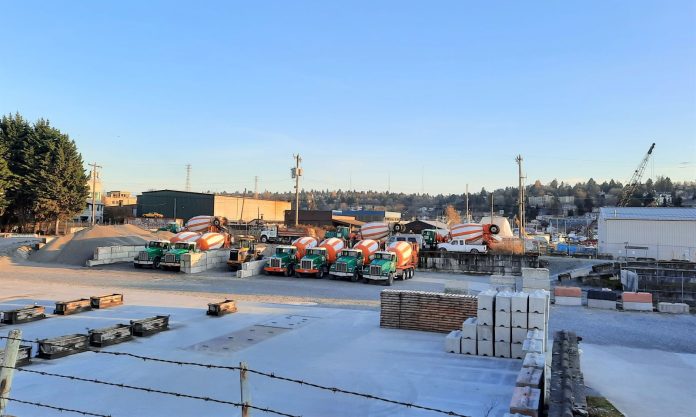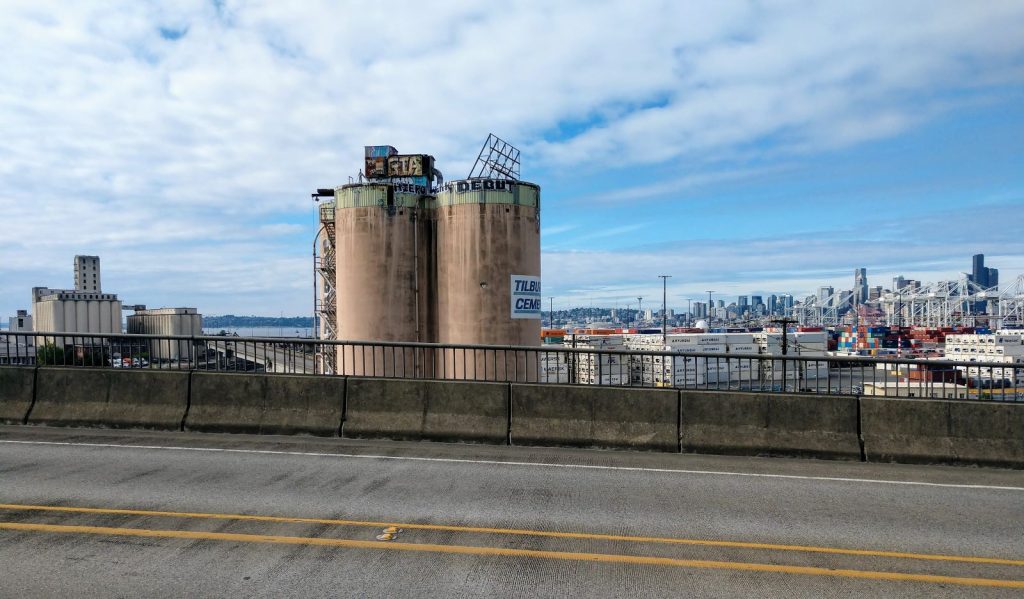
The Teamsters representing local concrete drivers rejected the latest offer from owners, which added just 15 cents to wages over three years.
The concrete strike continues, shuttering construction sites across the region, and federal mediation has shown little sign of breaking the impasse. The latest offer from the six largest concrete companies in the region constituted only $0.15 bump to hourly wages phased in over three years — ten cents after one year and five cents after year two, Teamsters’ Communications Manager Jamie Fleming said.
“I wish I had a better update, but this round of mediation went worse than the last one,” Fleming said in an email. “The ‘offer’ was a slap in the face, and clearly showed how little they care about the people who are hurting right now. So, the strike goes on.”
The Teamsters said they also revised their counterproposal in hopes of resolving the strike but didn’t receive a response. The Urbanist covered the previous contract proposals in our last installment on the concrete strike.
“We made two dramatic shifts to restructure our proposals in a way that would get people back to work immediately,” Fleming said. “The companies completely ignored our proposals and simply added another $0.15/hour over three years into their proposal. That works out to less than $1000 total over three years.”
The previous proposal from the companies was rejected by a resounding 212-1 vote of the concrete drivers represented by Teamsters Local 174. Expecting $0.15 over three years to entice workers to reverse their position seemed like wishful thinking on the part of concrete companies rather than a serious proposal to resolve the labor dispute. The top pay rate for mixer drivers is about $37 per hour, which is well behind other building trades, according to the Teamsters. The six companies offered a 17.6% raise over three years, they say. Teamsters counter that offer still trailed other building trade unions and failed to sufficiently account for inflation.
The six companies without contracts with concrete drivers are Glacier Northwest, Stoneway Concrete, Salmon Bay Sand and Gravel, Cadman, CalPortland, and Lehigh Cement. Four of the companies issued a joint statement on February 15th contending their offer was actually “generous” and competitive despite the now three-month strike suggesting otherwise. They followed up with a March 3rd statement arguing they were continuing to negotiate in good faith and that the union was attempting to “bully the construction industry” and deserved all the blame for the stoppage. “[T]he union can choose to allow its members the opportunity to vote the last offer presented by the companies,” the four companies added.
Local leaders have expressed an interest in ending the strike to avoid major delays to high-profile infrastructure projects like West Seattle Bridge repairs, Link light rail extensions, the Washington State Convention Center Addition, and affordable housing projects. The concrete stoppage is spilling over into other building trades as projects stall out. Half-finished highrises can’t rise higher and foundations mostly aren’t getting poured at new projects unless contractors mix concrete themselves or employ strikebreakers to deliver concrete in mixing trucks.

However, most leaders have stopped short of chastising concrete executives or demanding higher wages.
An update from Seattle Mayor Bruce Harrell’s spokesperson Jamie Housen suggests the Mayor has remained neutral. “The mayor has continued to stay in contact with representatives for labor and business, encouraging a return to the bargaining table and negotiations conducted in good faith,” Housen said.
Seattle City Council Kshama Sawant has taken a different approach, championing the cause of the concrete drivers and sharply criticizing ownership in press releases and during weekly Council briefings.
“My socialist City Council office, and my organization Socialist Alternative, stand unequivocally with our sisters, brothers, and siblings in the Sand and Gravel division of Teamsters Local 174 in their strike,” Sawant said in a statement. ““Some are saying that this strike must end, and workers must return to their job sites. Rank-and-file Teamsters also, understandably, want to get back to their daily lives. But the principal question is: on whose terms? On the condition of a strong contract for the workers who build our city, or on the terms of the exploitative bosses?”
Channeling socialist theorist Karl Marx, Sawant argued labor is entitled to all that it produces — which works out to more than a $0.15 bump in wages over the previous offer.
“The workers have been on strike for a fair contract now for over three months. Their courageous strike has slowed Seattle’s $23 billion construction industry to a crawl and is a reminder that the profits of the wealthy rest on the labor of workers,” Sawant added. “It is the greed of the contractors and their refusal to bargain in good faith that has put projects on hold and thousands out of work. Construction companies are making money hand over fist, but they have refused to agree to a fair deal with the workers who actually build these projects and produce the industry’s wealth.” [emphasis hers]
As she is wont to do, Sawant saw this particular labor dispute as part of a greater struggle by the working class.
“The outcome of the Sand and Gravel strike is of critical importance to the entire labor movement, and especially to building trades union members and workers,” Sawant said. “Construction workers, like so many other workers, are struggling with the pressures of inflation, skyrocketing rents, and inadequate wages, while a few billionaires continue to get unimaginably richer. Many construction workers cannot even afford to live in the communities that they help to build.”
Even a solid construction wage of $37 per hour is not enough to house a family in the Seattle metropolitan region. The average home price has crossed one million dollars in many Seattle neighborhoods and across the Eastside as the affordability crisis has worsened. In Bellevue, the median single family home price is a staggering $1.7 million as homebuyers race to beat the waves of Amazon and Facebook workers expected to move to take jobs at expanding corporate campuses in the city.
Sawant urged concrete workers to hold out for a good deal.
“The construction bosses are determined to break the Sand and Gravel strike and enforce a substandard contract in order to send a message to all building trades workers: don’t dare to fight for what you deserve,” she said. “This is precisely why all working people have a great deal at stake in helping our siblings win a victory in this strike. A setback for the Sand and Gravel strike will be used by the construction companies to clamp down on future action by construction workers.”
Sawant also encouraged workers to make common cause with the striking concrete drivers.
“I urge all labor unions and rank-and-file workers — union and non-union — to stand with our sisters, brothers, and siblings in Teamsters Sand and Gravel,” Sawant said. “In the face of stonewalling and attempted strikebreaking by contractor bosses, mass action is needed to win this strike. I appeal to all workers to refuse to cross the Teamsters’ picket line and to refuse to handle any concrete being used by the bosses to break the strike. The labor movement must rally behind the Teamsters with mass demonstrations of working-class solidarity.”
Sawant said she has donated $10,000 to the Sand and Gravel Teamsters strike fund from her solidarity fund, which comes from the excess in her Council salary above the average worker’s wage in the city. She urged other leaders and organizations to donate to the strike fund as well.
As the strike lingers those strike funds could take on growing importance as workers are forced to dip into savings and get temporary COBRA health insurance for their families as they lose their work coverage and wages. The concrete strike is turning into a war of attrition and neither side has flinched yet.
Author’s note: The article has been updated with the more recent statement from the four concrete companies.
Doug Trumm is publisher of The Urbanist. An Urbanist writer since 2015, he dreams of pedestrian streets, bus lanes, and a mass-timber building spree to end our housing crisis. He graduated from the Evans School of Public Policy and Governance at the University of Washington in 2019. He lives in Seattle's Fremont neighborhood and loves to explore the city by foot and by bike.

